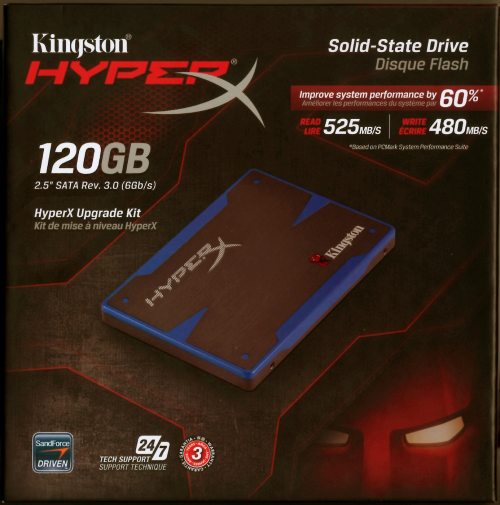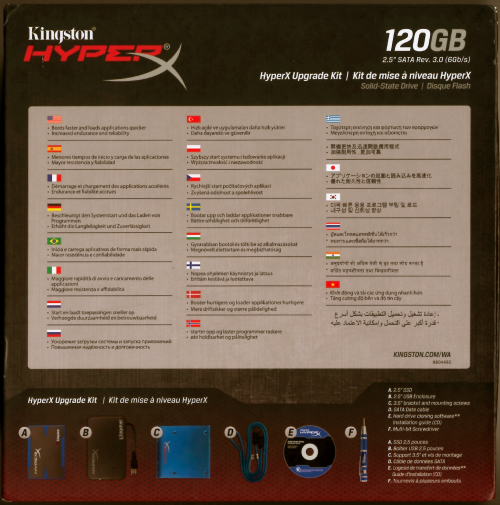The HyperX comes in an attractive black and red box which is surprisingly large for an SSD. Along with a picture of the drive, the front advertises many of its key features including its 120GB capacity, rated speeds, SATA Rev 3.0 (6Gb/s) interface and SandForce controller. The back of the box provides a bit more information as well as pictures of the box's contents.

The upgrade kit that Kingston sent us for this review includes a number of accessories. Along with the HyperX SSD you'll find a 2.5" SATA enclosure with a USB-to-mini-USB cable, Serial ATA data cable, 3.5" adapter bracket with screws, screwdriver and a CD containing hard drive cloning software.

While I could do without the fancy, pen shaped screwdriver, the SATA enclosure is a nice touch. It not only lets you clone your computer's existing hard drive and move your data to the SSD, it can be used to convert any 2.5" SATA hard drive or SSD into a USB powered, portable unit.

Physical Features:
While a bit heavier than other SSDs, Kingston's new HyperX SSD is very well constructed. The top of the outer casing is made out of bright blue plastic that matches the other products in Kingston's HyperX series. The top is also covered by a brushed aluminum panel with "HyperX" and "Kingston" logos on it. The bottom of the HyperX isn't nearly as flashy. The casing is made out of metal. However, instead of brushed aluminum, Kingston opted for a rough, matte finish.


Normally at this point, I'd break out the screwdriver and take a look at the inside of the HyperX. However, Kingston has made it very difficult to open up the drive. Along with the usual "warranty void if removed" sticker, the HyperX is put together using four security hex screws. There is no way to get these out without having the right sized bit and of course, it isn't included with the bundled screwdriver. Even if you were able to get the screws out, the shell is reportedly hard to separate due to the use of thermal padding. Needless to say, I left the HyperX in one piece.
If you were to open the HyperX, you'd see that it uses SandForce's SF-2281 controller chip. The SF-2281 can be found in a number of other SSD's including the ADATA S511, Corsair Force Series 3, OWC Mercury 6G, Patriot Wildfire and OCZ Vertex 3 as well as Kingston's own business-equipped SSDNow KC100. The 128GB version of the HyperX also uses Intel's 8GB 25nm 29F64G08ACME2 synchronous NAND flash chips. There are eight of these chips on either side of the PCB, which, if you do the math, equals 128GB and not the 120GB of storage the drive advertises. The SandForce controller uses this extra 7% (8GB) to maximize read and write performance and extend the endurance and overall reliability of the drive.



